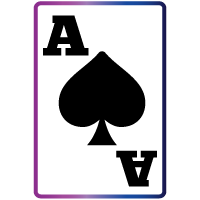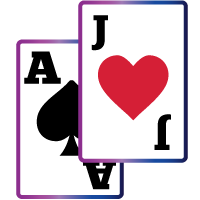Insurance in blackjack is just a side bet that is available when the dealer’s first card is an Ace, so why is it so important to learn how it works? I’m going to explain how blackjack insurance works and answer the $64 million question – when should you take insurance in blackjack.
What does insurance mean?
As I said at the top, insurance is a special side bet that is offered to you when the dealer gets an Ace and has a chance to make Blackjack. Insurance is simple – it is just a bet that the dealer’s next card will be worth 10. But why would anyone bet on the dealer making Blackjack?
Blackjack insurance was invented by casino bosses who liked the sound of inserting a new side bet during a game of blackjack. The name, betting and payout structure were all designed to appeal to players who were worried about the dealer making blackjack, and who might be willing to pay a little more for the chance to come away even, despite losing their main hand.
That’s why insurance is seen by some players as a way to break even – i.e. get your original stake back – if the dealer makes Blackjack.
Insurance in blackjack comes at a cost, and there are more outcomes than simply breaking even, as you’re about to discover. Ultimately, when asking what does insurance mean in blackjack, the answer is not about protecting a good hand or even salvaging something from bad initial hands. It’s just a very basic, stand-alone side bet at odds of 2 to 1 that the dealer’s second card will be worth 10.
The rules of insurance
Insurance is available at most online blackjack tables, and the rules of blackjack insurance are always the same.
Here are the 3 fundamental blackjack insurance rules:

Dealer up card must be an Ace

Costs 50% of original bet

Pays 2 to 1 if dealer makes Blackjack
Opinions on blackjack insurance vary from player to player. To some it’s a way of reducing variance when you play blackjack, smoothing out the natural swings that luck brings to this much-loved card game. To others it’s a side bet with a bigger house edge than the casino games it lives off.
With other side bets, you can win your main blackjack hand AND the side bet. This isn’t possible with insurance, as you’re hedging against your own hand. If you correctly bet that the dealer makes Blackjack, your own hand will automatically lose.
On the flipside, it is possible to lose the insurance bet AND the main hand, costing you a total of 1.5 betting units. This may be another reason that more experienced blackjack players always decline insurance.
Examples of insurance in blackjack
Insurance adds a second bet to the mix, and the dealer will settle both of them independently. Players who take insurance when they play blackjack will get their 1.5 units back around 30% of the time, so it’s worth understanding what happens in all of the other scenarios too.
In each of these examples, the player is playing a game which pays 3 to 2 for Blackjack. She has bet £10 on her main hand and paid £5 to take insurance for a total bet of £15.



How to say yes to insurance
The first thing to bear in mind when you’re choosing a table is the rules. The blackjack insurance rule and its odds will usually be printed in large lettering on the felt.
If the dealer shows an Ace, they will ask each player in turn if they’d like to take insurance. If you’re playing multiple hands, you can choose whether to take insurance on each separate hand.
In a land-based casino, the dealer will gesture in your direction and ask if you’d like insurance. A simple shake or nod of the head will be good enough to let them know what you want to do. If you’re playing online blackjack and insurance is available, YES or NO buttons will appear near to each of your hands.
Once all players have chosen to take or decline insurance, the game continues with each player taking their turn to play their hand.
When everyone’s finished, the dealer deals their second card and settles any blackjack insurance bets that have been placed. In some casinos, the dealer will deal their second card face down and peek once the insurance round has ended, and then settle those bets first.
A quick maths lesson on blackjack insurance
Although typical blackjack casino games have a house edge of less than 1%, the house edge for the insurance side bet varies from 5.8% in a single-deck game to over 7.5% in an 8 deck game.
As you can probably guess, the true probability of the next card being a 10 is lower than the probability implied by the blackjack payout odds.
Let’s keep things simple by using a single-deck game where the players’ initial hands are unknown. We know the dealer has an Ace, which means there are 16 cards left in the 51-card deck that are worth 10 (4 Tens, 4 Jacks, 4 Queens, 4 Kings).
16 / 51 = 0.3137 = 31.37% chance of a Ten
In general, if you place a bet that pays out 2 to 1, it only has to win 33.33% of the time for you to break even. But in the game above, the dealer will draw a 10 just 31.37% of the time. That difference of 1.97% may seem insignificant but it translates to a house edge of 5.8%.
Is there ever a good time to buy insurance?
Insurance strategy: 2 Good reasons to say yes
I’ve always felt that blackjack players should be free to make whatever decisions they want at the table, but here’s my own personal take on the best insurance strategy.
The simplest and best blackjack strategy for insurance is simply to always say no.
At between 4-8% on average (and as high as 14% if lots of Tens have already come out), the house edge compares poorly to the amazing 0.5% house edge of blackjack itself.
However there are 2 situations where the optimal blackjack insurance strategy might change.
#1: Counting cards
Learning how to count cards is the only way to make the insurance side bet profitable. Insurance is a bet on the value of the dealer’s second card, so if you happen to know there are more 10s in the deck than usual, you’re onto a winner.
The most popular card counting systems recommend that when the true count is +4 – indicating a deck rich with Tens – you take insurance.
Put simply, if you only take insurance when there is greater than 33% chance of a Ten coming out, you’ll make a profit in the long run. This rule of thumb is not useful when you play blackjack at a top online casino, as the cards are ‘shuffled’ by the RNG after every hand.
#2: Reducing risk in a single, high-stakes hand
Blackjack is all about the long run. Provided you practice sensible bankroll management and betting strategies, no single hand should ever matter so much that you deviate from basic blackjack strategy. But for argument’s sake, let’s say a player decided to play one hand of blackjack in their life, and then quit.
They are dealt Blackjack (*let’s all do the conga! Let’s all do the conga!*) but the dealer is also dealt an Ace (*booooooo*). In that situation, being able to book a guaranteed win by accepting Even Money might sound more appealing, given there will be no ‘long run’.
The Even Money rule
If you get dealt Blackjack however, you won’t be offered insurance. Instead you’ll get offered something called Even Money.
This is basically a version of the insurance rule which lets you take a guaranteed win at even money – 1 to 1 odds – instead of taking the risk that the dealer will also get Blackjack. Here’s how it works for a £10 bet….
Option 1: Accept Even Money
You win £20, no matter what the dealer has
Option 2: Refuse Even Money
If dealer makes Blackjack, you tie
If dealer does not make Blackjack, you win £25
Even Money may look different to insurance, but actually it produces exactly the same outcomes, just with a different name. Let me show you. Here’s what it would look like if we took insurance, having been dealt Blackjack:


In both cases, the players wins £10. Casinos recognised there’s no edge to be made or fun to be had in a side bet with the same result! Instead, Even Money creates the same conundrum that sportsbooks use for their Early Cashout offer.
It is the Blackjack equivalent of the old saying ‘a bird in the hand is worth 2 in the bush’.
But is it? Well with a 7% house edge, Even Money does not come cheap, but if you are someone who prefers to play it safe and enjoy a certain win, then it’s not the worst option in the world. It’s not for me though. I play Blackjack precisely to hit Blackjack itself, and when it comes along, I let the chips fall where they may. In the long run, you’re mathematically better off letting the hand play out as normal.
Summary
Don’t fall for the marketing. Blackjack insurance is not a way to protect anything, as there’s no guarantee you will. The fact you can take insurance and still lose both the side bet and your main bet is reason enough to give this feature a wide berth, or at least know what you’re getting into before you do.
Blackjack is so popular partly because of its incredibly small house edge, provided you play well. To me, there is little point in adding side bets with much higher house edges into the mix, unless they add significantly more fun and bigger payouts, like with the Perfect Pairs side bet.
Insurance doesn’t qualify on either count, but at least you now have all the info you need to make your own mind up! Instead of worrying whether to take insurance or not, I’d learn how to play blackjack really well, and then master Basic Strategy. That’s all you really need, if you want to give yourself the best chance to win at blackjack.
FAQ
In blackjack, the insurance side bet is only offered when the dealer’s first card is an Ace. If the player makes Blackjack and the dealer has an Ace, the dealer will offer ‘Even Money’ instead. Insurance is a bet with 2 to 1 odds that the dealer’s second card is worth 10 and therefore they make Blackjack. When the dealer has an Ace, insurance is considered a way to get your stake back instead of losing to Blackjack. But if the dealer does not get Blackjack, you lose your insurance side bet.
In purely mathematical terms, it is always better to avoid taking insurance in blackjack, because the house edge is 7 times higher than a regular blackjack bet. Some players believe the best insurance strategy in blackjack is to accept it if your bet was higher than usual. One successful blackjack insurance strategy is to take insurance if you are counting cards and the count is high. That’s because a high count means there are more tens in the deck, and the dealer is more likely than usual to make Blackjack. Insurance is only a side bet, not part of the main game, so it does not impact standard blackjack basic strategy at all.
Insurance is classed as a side bet, even though it is different to other blackjack side bets. Firstly, it is only available in certain situations, and the bet size is restricted to 50% of your original bet. But while blackjack insurance may not look or smell like a side bet, but it really is, because it is optional and doesn’t interfere with your main hand.
For some players, blackjack’s 21+3 bet has more appeal, because it has higher payout odds and a more interesting, traditional format for a side bet.


















